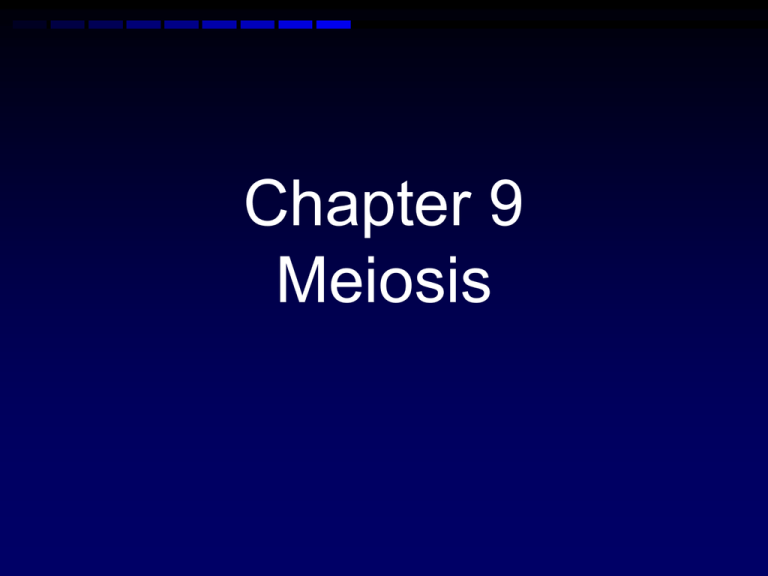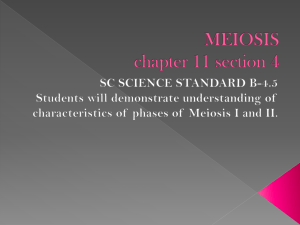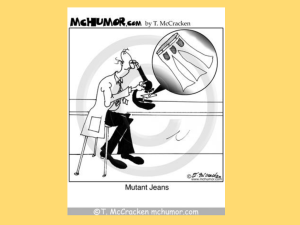
Chapter 9
Meiosis
Asexual vs. sexual reproduction
asexual: one parent
sexual: two parents
What is MITOSIS?
ASEXUAL
ASEXUALor
orSEXUAL?
SEXUAL?
Somatic (body) vs. Reproductive (sex)
somatic (body) cells: all the cells in your body
(muscle, liver, heart, tissue, etc.) EXCEPT for sex
cells
reproductive (sex) cells: sperm (male) and egg
(female) cells
Chromosome Number
Pairs of matching
chromosomes are
homologous
chromosomes
homologous: a
chromosome that has a
corresponding
chromosome from the
opposite sex parent
(one from the dad,
one from the mom)
Homologs have the same
genes, in the same order
along the chromosome
Karyotype
Homologous
chromosomes can be
arranged into a
karyotype
Humans have 23 pairs
of chromosomes
Is this a male or
female?
Chromosome Number
diploid: “two sets”; both sets of homologous
chromosomes
- human body cells have 46 chromosomes (diploid =
46)
- fruit fly has 8 chromosomes (diploid = 8)
haploid: “one set”; a single set of chromosomes (or
half the needed DNA)
- human sex cells have 23 chromosomes (haploid =
23)
- fruit fly sex cells have 4 chromosomes (haploid = 4)
Human Chromosomes
What if?
What would happen if two diploid cells
(with 2 complete sets of 23 chromosomes
or 46 total) came together during
reproduction?
How many chromosomes would that new
cell have?
92 chromosomes!
Would it be human?
Mitosis
You have already learned how a cell makes a
complete copy of its chromosomes in
But …
How do sex cells end up with half the
chromosomes that body cells have????
Meiosis
Life Cycle
Germ (or sex) cells fuse during fertilization to make a zygote
Purpose of Meiosis
To produce eggs and sperm with
only 23 chromosomes, so
fertilization can produce a
fertilized egg (zygote) with 46
chromosomes.
Meiosis
Specialized type of
cell division that
produces haploid
cells from diploid
parent cell
Stages of Meiosis
2 cell divisions after replication:
– Meiosis I
– Meiosis II
Each division has 4 stages:
–
–
–
–
Prophase
Metaphase
Anaphase
Telophase
Meiosis I: Interphase I
Interphase I
Prophase I
Metaphase I
Anaphase I
Cells undergo a
round of DNA
replication, forming
duplicate
Chromosomes.
Each chromosome pairs with
its corresponding
homologous chromosome to
form a tetrad.
Spindle fibers attach to the
chromosomes.
The fibers pull the
homologous chromosomes
toward the opposite ends of
the cell.
Meiosis I: Prophase I
Interphase I
Prophase I
Metaphase I
Anaphase I
Cells undergo a round
of DNA replication,
forming duplicate
Chromosomes.
Each chromosome
pairs in synapsis with
its corresponding
homologous
chromosome to form a
tetrad. Crossing over
may occur.
Spindle fibers attach to the
chromosomes.
The fibers pull the
homologous chromosomes
toward the opposite ends of
the cell.
“Crossing Over”
In meiosis, chromosomes get
together in homologous (similar)
pairs & crossing over occurs.
Pieces from one
chromosome break off
and rejoin the other!
Genetic Diversity
Independent
assortment and
crossing over
create new
combinations of
genes in
gametes
Prophase I Pause
Prophase I is longest phase of meiosis
Production of proteins and structures in egg
In humans, meiosis starts before birth, pauses in
prophase I until puberty, then 1 egg/month continues
for up to 40 years
Meiosis I: Metaphase I
Interphase I
Prophase I
Metaphase I
Anaphase I
Cells undergo a round
of DNA replication,
forming duplicate
Chromosomes.
Each chromosome pairs in
synapsis with its
corresponding homologous
chromosome to form a tetrad.
Crossing over at chiasma.
Spindle fibers attach to
the chromosomes.
The fibers pull the
homologous chromosomes
toward the opposite ends of
the cell.
Meiosis I: Anaphase I
Interphase I
Prophase I
Metaphase I
Cells undergo a round
of DNA replication,
forming duplicate
Chromosomes.
Each chromosome pairs in
Spindle fibers attach to the
synapsis with its
chromosomes.
corresponding homologous
chromosome to form a tetrad.
Crossing over at chiasma.
Anaphase I
The fibers pull the
homologous
chromosomes toward
the opposite ends of
the cell.
At the end of Meiosis I …
2 new cells are formed; although each new cell
now has 4 chromatids (as it would after
mitosis), something is different
neither of the daughter cells has the two
complete sets of chromosomes that it would
have in a diploid cell
the two cells produced by Meiosis I have sets of
chromosomes and alleles that are different from
each other and different from the diploid cell
that entered Meiosis I
Now on to Meiosis II …
There is NO Interphase II
so there is no DNA replication
Separation
of
Chromatids
Meiosis II: Prophase II
Prophase II
Meiosis I results in
two haploid (N)
daughter cells, each
with half the number
of chromosomes as
the original.
Metaphase II
Anaphase II
The chromosomes line up in a The sister chromatids
similar way to the metaphase separate and move toward
stage of mitosis.
opposite ends of the cell.
Telophase II
Meiosis II results in four
haploid (N) daughter cells.
Meiosis II: Metaphase II
Prophase II
Meiosis I results in two
haploid (N) daughter
cells, each with half the
number of chromosomes
as the original.
Metaphase II
Anaphase II
The chromosomes line The sister chromatids
separate and move toward
up in a similar way to
opposite ends of the cell.
the metaphase stage of
mitosis.
Telophase II
Meiosis II results in four
haploid (N) daughter cells.
Meiosis II: Anaphase II
Prophase II
Metaphase II
Meiosis I results in two
haploid (N) daughter
cells, each with half the
number of chromosomes
as the original.
The chromosomes line up
in a similar way to the
metaphase stage of
mitosis.
Anaphase II
The sister chromatids
separate and move
toward opposite ends
of the cell.
Telophase II
Meiosis II results in four
haploid (N) daughter cells.
Meiosis II: Telophase II
Prophase II
Metaphase II
Anaphase II
Meiosis I results in two
haploid (N) daughter
cells, each with half the
number of chromosomes
as the original.
The chromosomes line up
in a similar way to the
metaphase stage of
mitosis.
The sister chromatids
separate and move toward
opposite ends of the cell.
Telophase II
Meiosis II results in four
haploid (N) daughter
cells.
At the end of Meiosis II …
You have FOUR (4) daughter cells with the haploid
number (N) of chromosomes!
If this took place in …
… a male:
the new haploid cells will
grow flagella and become
sperm
… a female:
only 1 of the 4 haploid
cells will survive and
become an egg
Male + female =
A zygote
with
46
chromosomes!
Problems in Mitosis and Meiosis
What happens if something goes wrong during cell
division?
– In Mitosis, incorrect cell division or uncontrolled cell division
leads to cancer.
Cells divide incorrectly or too fast. This can lead to the growth of
tumors or abnormal cells that do not do their job correctly.
– In Meiosis, incorrect cell division leads to birth defects from
non-disjunction.
Nondisjunction
Occurs when chromosomes do not separate in either
anaphase I or anaphase II
Gamete is missing 1 chromosome or has 1 extra
chromosome
Fertilization will produce a zygote with 45 or 47
chromosomes
Down’s Syndrome
Trisomy 21 results from
nondisjunction of
chromosome 21
These kids have 3
chromosomes at pair 21.










